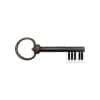HOW TO READ MUSIC:
THE KEYS TO TREBLE AND BASS CLEF
I bet the first time you saw a page of printed music, it was pretty intimidating. All those dots and symbols everywhere—and that’s supposed to be music? Well, in this episode, I’m going to clear up the mysteries of those symbols! Join me and you’ll learn all about:
- The musical staff
- Musical clefs and what they do
- The names of all the lines and spaces in treble and bass clefs
- How notes written on the staff correspond to notes on the piano
Are you ready to get the keys to reading music?
You’ve probably already guessed that what we need is some kind of written instructions for playing music! And that we need something quicker and more efficient than words. Let’s see what that involves:
By the way: the word “clef” comes from French. In French, clef means key! Learning the clefs really, literally, is the key to reading music!
Most children start singing before they even think about learning to play an instrument. Isn’t it interesting how the history of musical notation began with singing too? I love learning about music history and finding out how different aspects of music are connected to each other!
And just like that, you’ve learned all the notes on the lines and spaces of the treble and bass clefs! But before you start practicing, I have some tips for how to make your practice most effective. And Michelle has some really information to share about how the musical notation system we’re learning was invented.
It’s so easy to see the way music is printed now and imagine that that’s the way it’s always been. But knowing the whole story makes music so much more interesting. And I think that knowing why things are the way they are makes it easier to learn those things!
That really is good fudge. Now, I know you’re here to learn how to play the piano and how to read music, but I just can’t help sharing the recipe with you. You can check it out here! (By the way, that’s not an affiliate link: I just happen to love that recipe!)
Meanwhile, here are some other great ways you can practice reading music. (Disclaimer: though I am an experienced concert pianist and piano teacher, one way video lessons differ from in-person piano lessons is that I cannot give you feedback as you practice. If anything you do at the piano causes you pain, STOP IMMEDIATELY and seek medical input from a medical professional along with live input from a qualified piano instructor.)
Learn the Keys by trying these!
- Print out some staff paper (it’s in the folder with the flash cards!) and write notes on some random lines and spaces. Then play them!
- Sound out a melody on the piano. Name all the notes as you play them. Then write them down on staff paper.
- Read the most recent text or e-mail you sent. Whenever a letter from A to G is in that text or e-mail, write it on staff paper. Remember: you can write each letter on several different lines or spaces. Mix it up!
- Write the numbers one through five on small pieces of paper. Mix the papers up and pick one at random. Play the note that’s on that line, both in treble and bass clef. Do the same thing with numbers one through four, playing the notes on the spaces.
What other challenges and games can you come up with?
(Oh, by the way, if you’d like to watch this episode as one complete clip, it’s right here on YouTube.)
Until the next episode, happy practicing!


